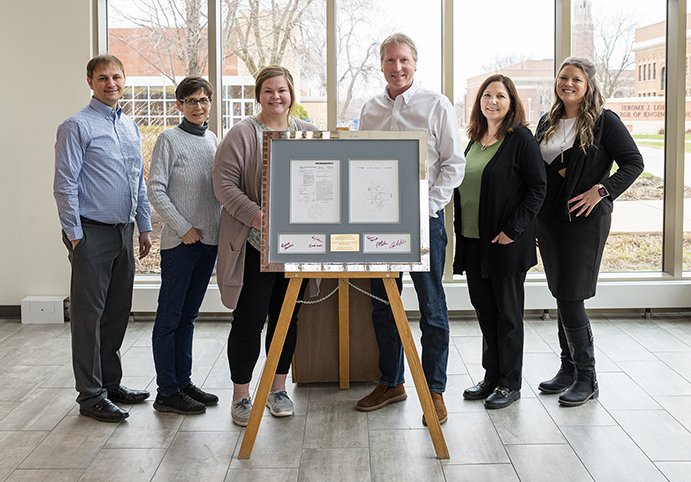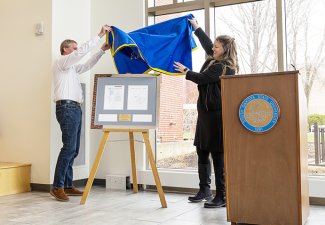
South Dakota State University’s Rich Normality Design Collaborative (RNDC), a multiprogram collaboration at the university, celebrated a patent-signing event on campus April 19.

The patent was issued in April 2022 for a connector device that promotes children’s building skills, and the event was used to highlight RNDC’s evolution at State and how the initiative helps build a pipeline of creative and innovative thinkers.
RNDC has grown to include six faculty from five academic units. To date, more than 200 students have participated in the program, leading to dozens of product concepts and prototypes, including the “Konnector” product and the resulting patent.
The RNDC emerged organically and engaged various stakeholders along the way, said Barb Heller, lecturer and entrepreneurship coordinator in the Ness School of Management and Economics.
“The team believed that if students developed entrepreneurial mindsets and gained experience working in cross-disciplinary teams, they would be more fully prepared to be leading professionals within multiple industries,” Heller said.
Joseph Santos, director of the Ness School, noted how important entrepreneurship is in what the school does. “We rely on entrepreneurs to assume uncertainty, for better or worse. Our well-being relies on the good work of entrepreneurs, so I think it’s really important that we have a major in the Ness School that emphasizes this crucial feature of our economic system. … I think this kind of innovative work is precisely the sort of thing we need to do to provide that greater good to the community,” he said.
The RNDC’s origin can be traced back more than 10 years, when the School of Education, Counseling and Human Development professor Kay Cutler and Chris Hume, founder of KODO Kids, a firm specializing in products for early childhood centers, preschools and day care centers, met at a conference. The pair found a common interest in encouraging children’s creativity and the role of a lab school and ways in which it might connect to business.
The following summer, Cutler’s materials and methods students worked on an exploratory project with a KODO Kids product. Later, an unexpected connection in education and interior design, between Cutler and former SDSU interior design faculty Angela McKillip, led to a group of interior design students developing innovative chairs and stools for KODO Kids in conjunction with mentor teachers from the SDSU lab school.
Then another interdisciplinary team of SDSU faculty members participated in “Pathways to Innovation,” an entrepreneurship and innovation program hosted by Stanford University’s Technology Ventures Program. They worked to identify key contacts and potential innovation champions already in place on campus and in the larger ecosystem.
Heller; Craig Silvernagel, associate professor of entrepreneurship and innovation management in the Ness School; and Todd Letcher, associate professor in the Department of Mechanical Engineering, connected with Cutler, McKillip and Roxanne Lucchesi, professor of advertising in the School of Communication and Journalism.
An expanded collaborative vision for the RNDC emerged, leading to the development of an innovative design experience that engaged faculty and undergraduates from five disciplines—interior design, advertising, early childhood development, entrepreneurial studies and mechanical engineering.
Lucchesi said her students recognized the value of cross-disciplinary brainstorming and creation. “It’s really fun for them to bring their discipline together with others, and they see the power of that,” she said. “They like to be challenged outside their comfort zone, and this definitely does that.”
Letcher said the next project to come out of the RNDC is working with the South Dakota Space Grant Consortium to design a NASA-themed exhibit for the Children’s Museum of South Dakota. He estimated as many as 150 students have worked on the design.
Design patent number 949,979 was issued April 26, 2022, and was the result of an RNDC iteration focused on developing product ideas for intergenerational interaction. The South Dakota Board of Regents is the patent assignee, and RNDC faculty and students and industry partner KODO Kids are co-inventors. The patent covers the design of the connection device to promote children’s building skills.
Signing the plaque recognizing the patent in the Harding Hall atrium last week were Cutler, Letcher, Tyana Bennett, a former SDSU student and now an SDSU kindergarten teacher; Sivernagel, Lucchesi and Heller.
- Contact:
- Telephone number: 605-688-5544
Republishing
You may republish SDSU News Center articles for free, online or in print. Questions? Contact us at sdsu.news@sdstate.edu or 605-688-6161.

